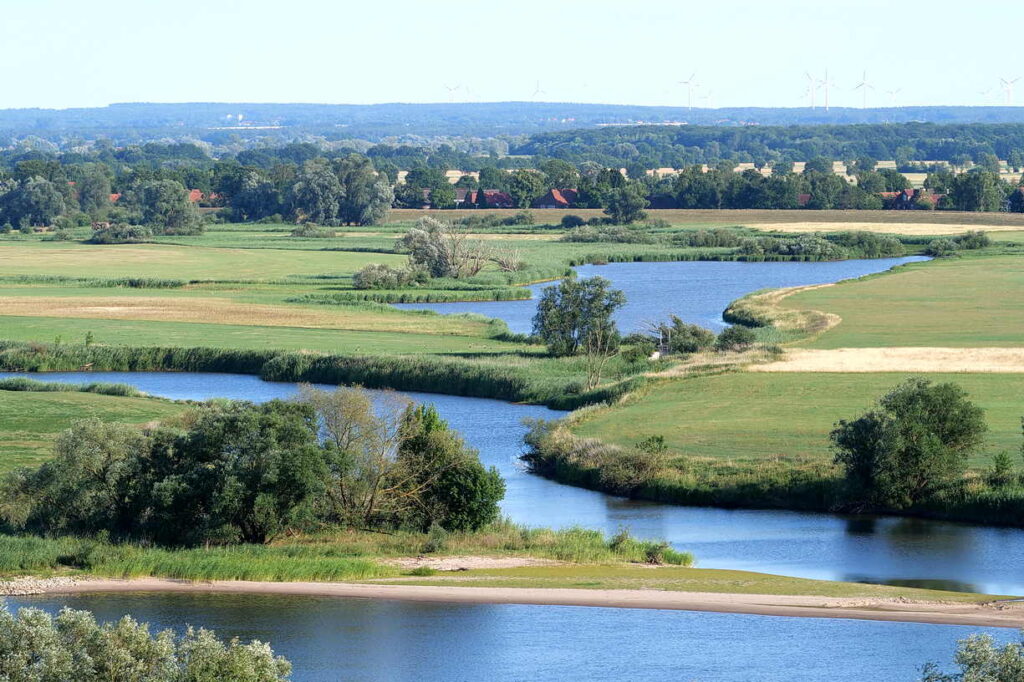Many of us are familiar with Biosphere 2, the research facility created in Arizona to demonstrate the viability of closed ecological systems to support and maintain human life in outer space. However, biosphere regions are model landscapes for sustainable development through collaboration and engagement. They are places designated for their unique beauty and biodiversity, and also recognized for their value to the communities of people living there, making them ideal models for large landscape conservation. The Center for Large Landscape Conservation’s Senior Conservation Scientist Dr. Annika Keeley recently had the opportunity to attend and present at EuroMAB—an international gathering of biosphere region leaders—to discuss the critical role connectivity conservation plays in these extraordinary places.

In the 738 biosphere regions worldwide* (also called biosphere reserves outside of North America), lands and waters are designated into three zones: Core areas comprise strictly protected ecosystems where only research and education activities are permitted. National parks are often at the core of biosphere regions. Activities in buffer zones should promote sustainable use and conservation, while also providing benefits to local communities. They may include, for example, sustainable agriculture and forestry, ecotourism, and traditional practices. People live in the transition zones, which generally support the greatest use and activities, and foster socio-culturally and ecologically sustainable development.
To promote the sharing of lessons learned, biosphere region managers worldwide organize themselves in regional networks. Sharing the focus on large landscapes, the Center for Large Landscape Conservation serves as the fiscal sponsor for the U.S. Biosphere Network (USBN), which fosters national and international connections among the 28 biosphere regions in the continental United States, the US Caribbean, Alaska, and Hawai’i.
Managers of North American and European biosphere regions meet every year to discuss different topics and exchange lessons learned. The conference hosted at the Elbe River Landscape Biosphere Reserve in Germany in June of this year was an opportunity for the Center to stimulate a discussion around ecological connectivity because counteracting fragmentation is vital for sustainability and resilience of all landscapes. For example, in the Crown of the Continent biosphere region, which straddles the US and Canada, maintaining habitat connectivity for large mammals such as grizzly bears is a key concern. In the Congaree Biosphere Region in South Carolina—home to the largest, contiguous, intact expanse of old-growth forest remaining in North America—free-flowing watersheds are crucial to sustaining the forest. These same watersheds and forests also provide ecosystem services, such as clean air and clean water.
Together with Jeremy Dertien with the German Centre for Integrative Biodiversity Research, and Ancuta Fedorca at the National Institute for Research and Development in Forestry in Romania, Annika organized a half-day workshop to share guidelines and insights about connectivity conservation and discuss challenges and opportunities of establishing ecological corridors in biosphere regions. To introduce the topic, she presented the IUCN connectivity guidelines as best practices to consider for biosphere regions. Jeremy also shared the new Guidelines for Connectivity Conservation in Europe and progress towards modeling connectivity for all of Europe.
Two case studies illustrated aspects of connectivity planning and implementation in biosphere reserves, highlighting challenges and solutions. Ancuta shared that in Romania, genetic data on brown bears help scientists plan for the locations of movement corridors and crossing structures to mitigate the fragmenting effects of roads.
Ruth Simons explained that in British Columbia, Canada, an initiative led by the Squamish Environment Society, the Howe Sound Biosphere Region Initiative Society, and a coalition of local and regional planning authorities support land managers in safeguarding and restoring pathways of wildlife connectivity that are needed to increase ecosystem resilience to climate change in two biosphere reserves.
During a lively discussion, participants shared insights on efforts to establish ecological corridors, socio-cultural challenges and opportunities for planning and establishing corridors, and technical challenges around planning for connectivity conservation.
In 2025, the global biosphere conference will take place in China with the goal of passing the biosphere reserve strategy and action plan for the next 10 years. The workshop participants formulated a recommendation for the global biosphere reserve community to consider for inclusion in the strategy and action plan:
“The “Post-2025 Strategy and Action Plan” should support Biosphere Reserves in planning and implementing ecological corridors in addition to core areas, buffer zones, and transition areas, in order to maintain or restore effective ecological connectivity, reduce fragmentation and increase resilience.”
We will keep you updated on the matter as we learn whether ecological corridors will become a tool widely promoted in biosphere regions globally.
*Biosphere Reserves are designated under the intergovernmental MAB Programme by the Director-General of UNESCO (United Nations Educational, Scientific and Cultural Organization) and their status is internationally recognized. Member States can submit sites through the designation process.
Top photo: Participants of the 2024 conference of the American and European Biosphere Regions, Elbe River Landscape Biosphere Reserve, Germany. Credit: ©Deutsche UNESCO-Kommission/Stefanie Wetzel



